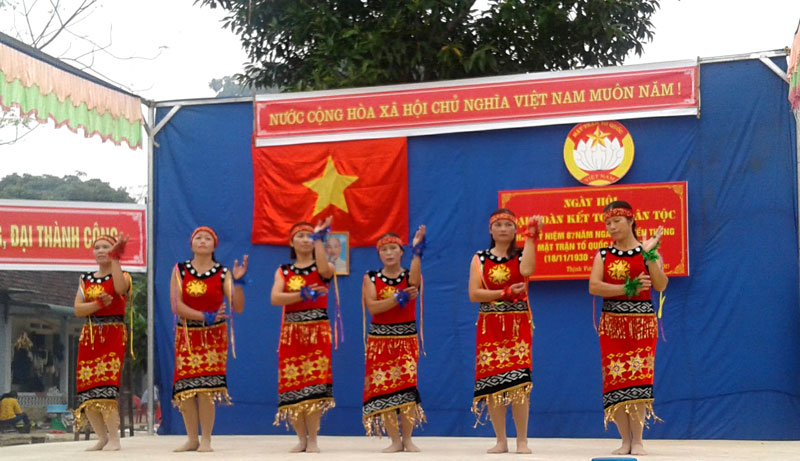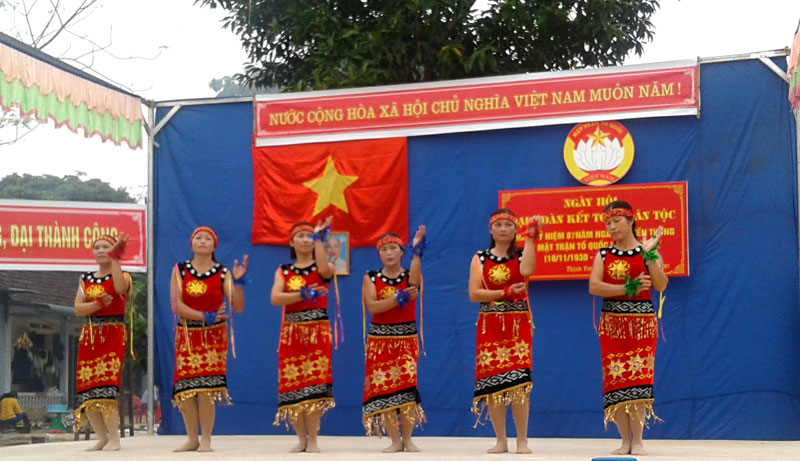
(HBO) - Determining that the economic development, hunger eradication and poverty reduction are the most important tasks in building a new cultural life, the Steering Committee of the commune has cooperated with the Fatherland Front and other mass organizations to actively propagate and mobilize the people to transfer the appropriate crop structure, implementing the land consolidation and plot exchange, using new varieties and applying techniques in production and so on.
Accordingly, the average income per capita of the commune has reached 31.5 million VND. The rate of the poor households has decreased to 6.39%. The people have agreed to join hands in building a new countryside. Currently, Lac Thinh has reached 13 out of the 19 criteria of building a new countryside. Among the unfulfilled criteria, it is difficult to achieve the criteria of cultural and physical foundations. To solve the above problem, the Party Committee and the People’s Committee of the commune have actively mobilized people to donate land to build the cultural houses and they have received enthusiastic responses from the people.

The people in Lac Thinh commune (Yen Thuy) have been actively participating in cultural and arts movement to enrich their spiritual life.
The purpose of building a new cultural life is to push back the backward customs and practices and to promote the fine traditions and customs and the identity of the national cultural traditions. More than 80% of Lac Thinh's population is Muong. In the past, the wedding party used to last for many days, now it has been improved significantly. Most of the weddings have been organized according to a civilized lifestyle, not for a long time, there is no situation of being drunk leading to fighting and causing disorder. The funeral has also changed positively. All the funerals have been organized simply, thoughtfully and respectfully by the party committee, the committee of the front and the unions and other organizations.
In addition, the Party Committee and the People’s Committee of Lac Thinh commune are paying special attention to preserving the national cultural identity through the cultural and artistic activities and the traditional local festivals. Currently, each hamlet has set up their own arts team. On the occasion of holidays, New Year, the arts teams exchange with each other. The performances of gongs and songs of Muong people are nicely shown by the nucleus of arts. Additionally, De Rice Tet is a unique cultural feature of Muong ethnic people in Lac Thinh. Every year, on October 26 of the lunar calendar, the people of Muong Ram organize their traditional De Rice Tet
Thanks to the effective implementation of the movement to build the cultural life, in 2018 there were 8 out of the 15 villages reaching the cultural villages in Lac Thinh. 78% of the households reached the title of the cultural families. In 2019, implementing the merger, there are only 11 helmets in the commune. They are trying to have 8 out of the 11 villages reaching the cultural villages with the average income per capita of 33.5 million VND.
With an increasingly vibrant and widespread emulation movement aimed at building cultured residential areas and cultured families, Yen Thuy District has been making steady progress toward improving both the material and spiritual well-being of its people, while fostering a civilized, prosperous, beautiful, and progressive community.
Once lacking recreational spaces and community facilities, Residential Group 2 in Quynh Lam Ward (Hoa Binh City) has recently received attention for the construction of a new, spacious, and fully equipped cultural house. The project followed the model of state support combined with public contributions in both labor and funding.
The "All people unite to build cultural life" movement, which has been effectively integrated with Kim Boi district’s socio-economic development goals, is fostering a lively spirit of emulation across local residential areas, hamlets, villages, public agencies, and enterprises. In addition, through the initiative, traditional cultural values are being preserved and promoted, while community solidarity and mutual support in poverty reduction and economic development are being strengthened.
A working delegation of the Hoa Binh provincial People’s Committee led by its Permanent Vice Chairman Nguyen Van Toan on June 11 inspected the progress of a project to build the Mo Muong Cultural Heritage Conservation Space linked to tourism services in Hop Phong commune, Cao Phong district.
Born and growing in the heroic land of Muong Dong, Dinh Thi Kieu Dung, a resident in Bo town of Kim Boi district, in her childhood was nurtured by the sweet lullabies of her grandmother and mother. These melodies deeply imprinted on her soul, becoming an inseparable part of her love for her ethnic group's culture. For over 20 years, this love for her hometown has driven Dung to research, collect, and pass down the cultural values of the Muong people to future generations.
In the final days of May, the Ethnic Art Troupe of Hoa Binh Province organized performances to serve the people in remote, mountainous, and particularly disadvantaged areas within the province. These were not just ordinary artistic shows, but they were the meaningful journeys aimed at spreading cultural values, enhancing the spiritual life of the people and contributing to the preservation of ethnic minority cultural identities.



